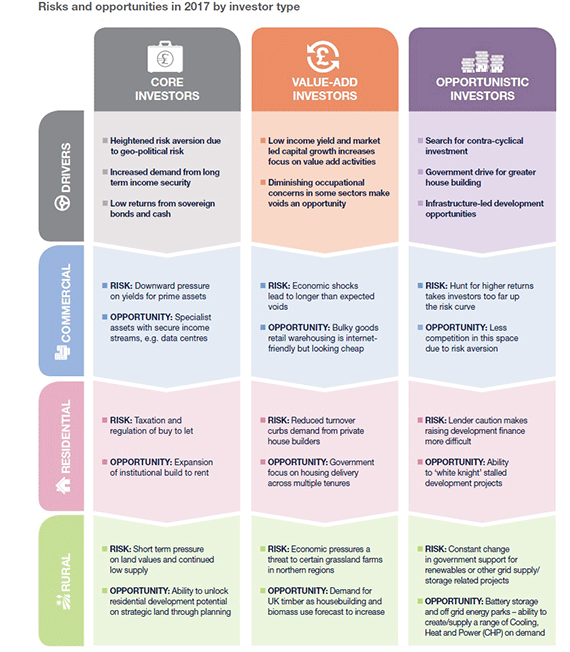Secure income streams will be more highly prized in 2017, according to Savills.
The advisory firm says the unexpected political events of 2016 will make investors more cautious but adds that this could benefit the UK, where high levels of transparency and stable legal structures make real estate a “safety play”.
Across the UK growth is expected to slow, with house prices remaining stagnant, before rising by 2% in 2018 and by 5.5% in 2019. An imbalance between supply and demand means rents will outperform house price growth, rising by 19% over the same period.
Total returns on commercial property are expected to be 5.6% pa from 2017 to 2021 with 0.4% five-year capital growth forecast for office values and 4.4% growth forecast for office income returns.
Savills also forecasts 32% average five-year capital growth for forestry land in Great Britain and 5.5% average five-year capital growth for farmland.
Greater political risk will mean a strong focus on sectors where the fundamentals of supply and demand are most insulated, such as retirement housing, logistics and energy.
For opportunistic investors, the continued ultra-low interest rate environment will limit the extent to which distressed assets hit the market. These investors will instead look towards mixed-use development opportunities linked to infrastructure improvements.
A less crowded marketplace for the value-add investor is predicted, particularly if lender caution results in tighter borrowing criteria in the development sector.

Mark Ridley, chief executive officer, Savills UK and Europe, said: “‘Expect the unexpected’ is now the norm, not the exception, on the world stage. Despite this, property remains a fundamentally safe asset class, providing strong income returns and, in many cases, a refuge for capital preservation in the longer term. Its appeal remains resolute.
“Nationally, the markets continue to appear robust in all sectors, although there remains some hesitation on what Brexit will mean in the financial markets and biomed property, and also in an agricultural marketplace without EU subsidies.
“The sterling devaluation has made UK property very attractive for international investors pegged to the US dollar or euro, with 2017 activity in central London likely to be dominated by Asian investors. American and Pan-European investors will also be active nationally.”

Commercial predictions for 2017 and beyond
• Global hunt for income will drive price rises in UK.
Uncertainty, rising demands from pension funds, and low bond yields will continue to drive appetite for assets that deliver secure income, such as long-let City offices, index-linked warehouses, or alternative asset classes. Demand for such assets is likely to exceed supply, and Savills expects to see improving capital value growth.
• Non-domestic investor interest in the UK will continue to rise.
The next five years are likely to see record levels of international investment in assets outside London.
• Opportunities are available in logistics facilities in strong locations such as the Midlands and the M25 area.
With availability at record lows and demand unaffected by the uncertainty, this sector looks likely to continue to outperform the rest of the market, owing to its long and often indexed leases, as well as the landlord-friendly dynamics in the occupational market.
• High-quality regional office assets should also perform well.
Generally less affected by post-referendum uncertainty, these assets, particularly new and refurbished space, are at low levels of availability in many markets while demand is likely to remain high, supported by some large organisations continuing to relocate functions outside London.
• Development activity is predicted to fall by 30-40% owing to lender and borrower risk aversion.
• The rental market is changing shape.
Tenants may demand greater flexibility when signing leases but occupational demand will be maintained. Declines in development activity, which are likely to be most intense in 2019-21, will lead to falling grade A vacancies and rising rents towards the turn of the decade.
Residential predictions for 2017 and beyond
• House price growth will fall.
Average house price growth will be low over the next two years, but an extension of the low interest rate environment will prevent a price correction. Mainstream house price growth is likely to rise by 13% by 2021, with East of England the top performer at 19%, and the North and Scotland averaging just 9%.
• The EU referendum vote has compounded the stamp duty effect on prime residential property.
This signals two flat years before a return to growth in 2019. Prime markets are likely to outperform the mainstream over the next five years to the end of 2021.
• Transaction volumes will fall by 16% over the next two years, recovering to 2016 levels by 2021.
However, individual buyer groups will be affected differently. Fewer transactions are expected to continue driving demand into the private rented sector from frustrated would-be home owners.
• Opportunities for private investors lie in restoration projects in the commuter belt and buy to let properties in university towns where student lets offer good yields and where values have been slow to recover.
Agricultural predictions for 2017 and beyond
• Low commodity prices and patchy local demand continue to affect the land market.
Despite the benefits of the weak pound on outputs and subsidies, Savills expects the average value of “all types” of farmland to remain under some pressure in the short term as debt in the industry filters into sales.
• Debt pressure is the single biggest factor that has the potential to increase supply.
Debt-related sales could account for 20% to 25% of all transactions in 2017 but the effect will be tempered by the increase in the 2016 EU subsidy and the positive effect of the weak pound on commodity prices.
• The rental market will remain under some pressure.
But this will be alleviated by the scarcity of supply as well as demand from those looking for efficiencies through economies of scale. The subsidy review in 2020 will cause great uncertainty and affect the number of potential bidders for new rental opportunities.
• The impact of the UK’s vote to leave the EU on farmland values is likely to be muted.
The weak pound and potential lack of supply will create a favourable buying environment for overseas purchasers and those willing to move away from traditional assets. Long-term fundamentals still apply with increased food production (balanced by a reduction in food waste) and competitive land use driving demand supported by a favourable tax regime.
• The prospect of a longer-term upward trend in UK timber pricing structures makes forestry an attractive asset for long-term portfolio diversification and wealth preservation.
Well-managed commercial spruce forests with good access to timber markets will remain in strong demand, supported by the weaker pound and domestic demand from the construction industry.
• To send feedback, e-mail shekha.vyas@estatesgazette.com or tweet @ShekhaV or @estatesgazette














